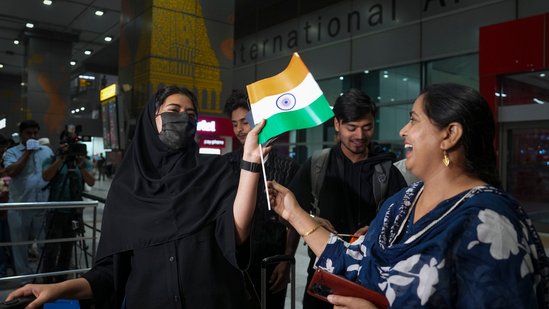As tensions exploded between Iran and Israel, India swiftly responded with a bold and compassionate move – launching Operation Sindhu to evacuate its nationals from the escalating conflict zone. With thousands of Indians, many of them students, stuck amid airstrikes and uncertainty, the operation reflects India’s readiness, resilience, and international diplomacy under fire.
Overview of Operation Sindhu
At a time when the globe is already troubled by growing global disorder, the Middle East now has returned to center stage of conflict. This time, it is a deadly exchange of missiles and drones between Iran and Israel that has caused alarm around the world. As tensions in the region mounted, India activated a humanitarian evacuation – Operation Sindhu – that sought to bring its nationals caught in the firing back home.
Operation Sindhu, revealed on Wednesday, will see thousands of Indian nationals returning from Iran and Israel. With some 10,000 Indians in Iran alone, many of them students, the mission has become a logistical and diplomatic ordeal for New Delhi.
Operation Sindhu: Mission Brief
Operation Sindhu: India undertakes evacuation of its citizens from Iran, Israel as hostilities escalate between the two nations. Israeli airstrikes against Iranian military and nuclear facilities set off a chain of escalation, pitting Iran and Israel against each other with hundreds of missiles and drones. Civilian areas and major cities grew more dangerous, and India decided to move quickly.
- The choice to start evacuations was not only timely, but essential.
- India has not yet issued an official advisory asking its citizens to leave either country, but has been strongly emphasizing caution.
- Iranian and Israeli nationals have been warned to be vigilant and keep a low profile.
- It also called on Indian citizens to move away from the Iranian capital to more secure locations.
Diplomatic Coordination and Groundwork
It’s a heck of a task to carry out a multi-country evacuation. The initial effort was to transport its own citizens across land borders to third countries, where they would be flown back to India. From Iran evacuees were to be flown to Armenia and Turkmenistan. At Israel, the evacuations routes were to Egypt and Jordan.
On Friday, a senior Iranian diplomat said Iran had begun relaxing its airspace ban to permit three charter flights to evacuate some 1,000 Indian nationals. These people had already been transferred from Tehran to lesser imperiled Iranian cities like Qom and Mashad.
“We have suspended all flights on the day of the incident because we have no idea to provide facilities for the Iranian delegation to reach India.” – Iran’s embassy
Iran’s embassy in a statement said that the country’s airspace was closed but that it was arranging to open it for the passage of Indian nationals.
Hosseini said three charter flights – all flown by Iranian planes – would be utilized to take the 1,000 Indians home. The first such flight was to arrive in New Delhi on Friday night; the other two on Saturday.
Apart from these, another flight was also planned to repatriate Indians who were shifted from Iran to Turkmenistan over a land crossing. That Ashgabat flight had been due to arrive in Delhi shortly after midnight on Saturday.
Also read, 5 Air India Dreamliner International Flights Cancelled Today
Special Thanks to Coordinating Nations
The Indian authorities publicly acknowledged the support of the Iranian and Armenian governments in providing safe evacuations. Diplomatic choreography for a smooth and safe extraction also has been key.
Iran’s foreign ministry is in touch with India’s external affairs ministry and its embassy in Tehran. Both sides are coordinating efforts to facilitate Indians’ return either via direct flights from Iran or the overland route to third countries.
“We’re making arrangements for the safe return home of Indian nationals who have desired to return home, either from air or from land,” Hosseini added, “be it the land through third countries, or directly from Iran.”
Ground-Level Operations And, What The Indian Embassy Did
The evacuation flights are what make the news, but there was plenty of ground work done in relative quiet. The Indian embassy in Tehran swiftly located and moved citizens, particularly students, of the submerged areas to safer regions. Cities including Qom and Mashad served as staging points for evacuations.
- Emergency helplines have been set up by the Indian embassy and the Ministry of External Affairs (MEA) in New Delhi.
- Indians in Iran have been advised to refer to these mediums for timely information and assistance.
The Tragicomic Plot of Indian Students and the Attack on the Tehran Dormitory
One of the most poignant stages in the war was when Israel bombed a student dormitory in Tehran. A vast number of Indian students, especially from Kashmir, were living in the complex. At least three Indian students were injured by shrapnel during the attack.
“I don’t understand why the Israelis bombed the dormitory of Indian students. It is not only a vivid illustration of the vagaries of war, it also highlights its human toll.”
While most Indian nationals in Iran were known to be safe, the attack provided a sobering reminder of why evacuations were so necessary. The evacuated students comprised a batch of 110 who first shifted from Tehran to Qom then who travelled by road to Armenia. They had landed in New Delhi safely on a flight from Yerevan on Thursday.
The Magnitude of the Challenge
At the outbreak of hostilities, there are at least 10,000 Indians in Iran. Most of them are students enrolled in professional and academic courses. As education base had drawn Indian nationals for training over the decades, the Iranian crisis risked a large section of Indian youth.
This is more than just flights and logistics. Operation Sindhu is a multi-faceted initiative that includes diplomacy, working with foreign governments, ferrying people through active war zones and dealing with emergencies including injuries or sudden lockdowns.
So far India has stopped short of calling all citizens to leave Iran. The two countries are possibly too widely dispersed, the issues too sensitive. But it has also issued deffers on vigilance, safe movement and prompt registration with Indian authorities.
Continuous Monitoring and Next Steps
Hosseini said more flights may be scheduled in the days ahead, including one on Sunday, for remaining Indians still in Iran who wish to return. The operation is very much a live one, with India’s government watching and willing to ramp up the response as necessary.
Even more heartening is the partnering between India and the Iranian authorities. The Iranian ambassador said that both sides were cooperating for both air and road evacuations. Here is one of the best examples of international cooperation in a crisis.
Also, noteworthy here is how India has elected to avoid using Pakistani airspace for these flights. It indicates a need for careful route planning to prevent unwanted diplomatic or security entanglements in an already fraught evacuation.
Also read, Satellite Images Show Massive Damage To Iran’s Arak Nuclear Facility
A Model for Crisis Response
Operation Sindhu is emerging as a case study of how swift action, coupled with diplomacy and ground-level preparedness, can help save lives within a conflict zone. The rapid evacuation of people, the resort to alternative border crossings, the chartered air evacuations, and the medical care for the wounded suggest that the operation is more than just a political message: it’s also a humanitarian one.
Shunning panic, but preparing efficient evacuation plans, India is jotting down in ink what used to be a pencil and paper practice till long ago up. Had the authorities issued an immediate mass evacuation order, they would probably have run up against even more crowding, logistical tangles, and the danger of accidents.
Guidance to remain vigilant, limit travel and sign up with embassies, rather than rushing to the airport, resulted in a far more phased, controlled, safe departure.
Conclusion
Operation Sindhu is about more than repatriation – it is an affirmation of India’s ability to respond to a crisis with clarity, compassion and coordination. In a region where missiles and drones are darkening the skies over Iran and Israel, India has illuminated a path to safety for its stranded citizens. The operation has demonstrated how when diplomacy is blended with logistics and clear communication, even the most intractable international emergencies can be conquered. With thousands still in the region there will need to be continued vigilance and cooperation in order to ensure this operation is a complete success.
FAQs
- Q1: What is Operation Sindhu?
A1: Operation Sindhu is India’s mission to evacuate its citizens from Iran and Israel following growing military tensions between both the countries. - Q2: Initially how many Indians were evacuated?
A2: About 1,000 Indians were supposed to be evacuated in three chartered flights from Iran and 110 students flew out through Armenia. - Q3: Any Indian nationals being injured reported?
A3: Yes, three Indian students were wounded by shrapnel when an Israeli air raid struck a dormitory in Tehran. - Q4: Is the airspace of Pakistan being used for evacuation flights?
A4: No, Pakistan’s airspace will not be used by any of the evacuation flights. - Q5: What are the advisories in place for Indians in Iran and Israel currently?
A5: Though there is no mass evacuation alert, Indians have been asked to remain alert, limit their movement and in touch with Indian embassies.
Reference
Stay updated with all the latest news and insights – News Of US






